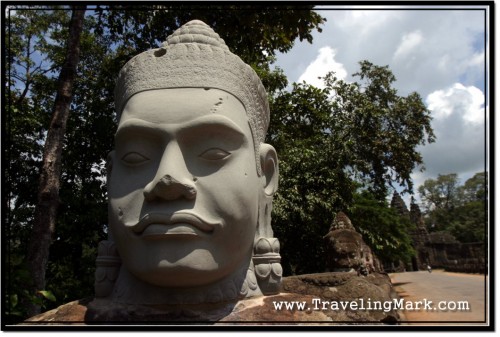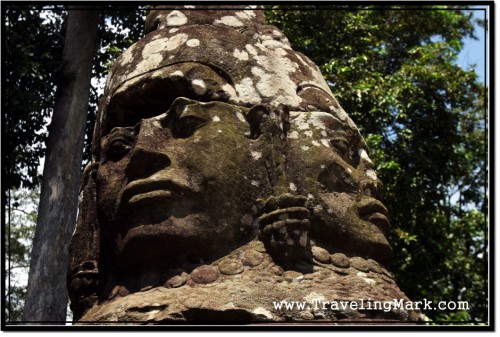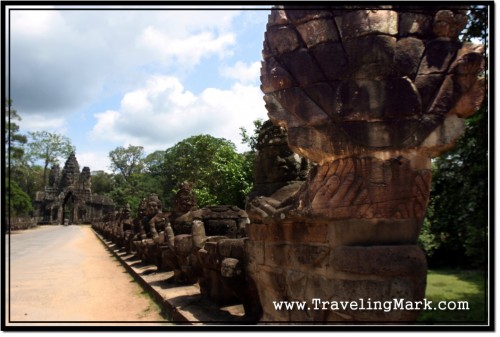Known as Yashodharapura, the South Gate of Angkor Thom is the nearest point of entry to the royal city of Angkor Thom from Angkor Wat (and Siem Reap). There are five entrance gates to Angkor Thom – one at each cardinal point and a Victory Gate, which is on the eastern wall and affords access to the royal palace area, but South Gate is hands down the most popular and the most congested. All of the Angkor Thom gates look virtually the same, but because South Gate is the point of entry for vast majority of visitors to Angkor Thom, this gate is the most complete thanks to extensive restoration works. Just as most tourists do, I started my Angkor adventure with Angkor Wat too (not realizing at the time that it was not a good idea), which had me enter Angkor Thom through South Gate.

The laterite causeway that crosses over the surrounding moat to approach the Angkor Thom South Gate is lined on both sides with a naga (multi-headed serpent) balustrade held in place by statues of Apsaras (gods) on the left, and statues of Asuras (demons) on the right striking a pose resembling the tug of war. These figures previously existed at each of the causeways leading to Angkor Thom but most have been stolen. South Gate is the only one that’s vastly complete. North Gate still has several full figures but other gates were stripped of most of them with only a few remaining. Many of the missing heads along the causeway approaching South Gate have been restored with new ones, while a couple were still missing, waiting to be restored (at the time of my visit). There are 54 figures on each side of the causeway.

The gates themselves, which reach as high as 23 meters (75 feet) are surmounted by a structure with four faces each facing its own cardinal point. This symbolism is seen on many temples built by Jayavarman VII, including Angkor Thom’s state temple Bayon and Banteay Kdei which is on the eastern side of the small circuit. The faces represent the likeness of bodhisattva Lokeshvara, the deity with whom god-king Jayavarman VII identified.

Base of the South Gate tower is decorated on both sides by a three-headed elephant plucking lotus flowers. The trunks of an elephant form three pillars and are believed to represent Airavata, the mount of Indra. God Indra is the god of the sky and the king of the gods. His presence at each of the gates leading to Angkor Thom reinforces the idea that naga balustrades lining the approach to each of the gates were built to represent a rainbow – in Khmer mythology, rainbows are believed to link the world of men with the world of the gods.

If Angkor Thom was built as a representation of Mount Meru with the moat serving as the sea of milk that surrounds it, then naga balustrades would represent rainbows connecting the world inside of the temple (world of the gods) with the world outside of it (world of men). I was coming from the outside, entering Angkor Thom, world of the gods through the South Gate. I was drenched in sweat, worn out by the heat, but excited to explore the largest Angkor compound still standing.
